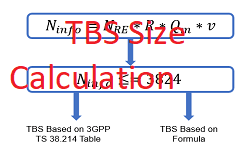Transport Block in 5G NR, is nothing but the payload which is passed between the MAC and Phy Layers, specifically for the shared data channel such as PDSCH and PUSCH. A Transport Block undergoes Phy layer processing at the transmitter before being mapped onto the PDSCH for transmission over the air interface. A Transport block is added with CRC and segmented into code blcoks as shown as below. The transport The transport block consists of up to million bits and the code block consists of up to 8448 bits.
Factors Affecting Transport Block Size:
Device receiving data on the PDSCH has to determine the Transport Block Size (TBS) before attempting to decode the data. The UE uses information provided by RRC signalling and Downlink Control Information (DCI) over the PDCCH depending on scheduling type i.e. semi-static or dynamic scheduling.
Following picture depicts a simplified diagram to get Transport Block Size and provided lists of parameters which affects the TB size.
- No. of Layers (v)
- Modulation Order (Qm)
- Coding Rate (R)
- No. of Physical Resource Block (PRB)
- Transmission Duration
How to Calculated Transport Block Size
In 4G LTE, the transport block size is provided in a table which was a function of the MCS field and the Resource Block Allocation (PRBs). However, 5G NR support significantly larger bandwidths, together with a wide range of transmission duration and variations in the overhead depending on other features configured such as CSI-RS. It would result in a large number of tables required to handle the large dynamic range in terms of transport block sizes.
Such a scheme may also require modifications whenever some of these parameters change. Therefore, 5G NR has opted for a formula-based approach combined with a table for the smallest transport block sizes instead to obtain the necessary flexibility.
Step to Calculated TBS
- The UE determines the no. of REs
where
- If the value of
- The final
- The value of
- The total no. of REs available for data transfer is then converted into a no. of information bits. The no. of information bits depends upon the modulation scheme, the coding rate and the number of layers, i.e. the use of MIMO. The UE uses the following equation standardized by 3GPP .
-
-
-
-
- R is Code Rate
- Qm is Modulation Order
- v is no. of MIMO layers
-
-
- The Modulation Order and Target Code Rate are both extracted from an MCS table
- N0. of Layers is fixed to ‘ 1’ if the PDSCH resource allocation has been received using DCI 1_0. Otherwise, the no. of Layers is obtained from the ‘DMRS Ports’ column within the “Antenna Ports’ look-up table used by DCI 1_1. The number of layers is equal to the number of allocated DMRS Ports
-
- If
- https://5g-tools.com/5g-nr-tbs-transport-block-size-calculator/The threshold of 3824 bit is based upon the maximum code block size of 3840 bits which can be processed by LDPC channel coding when using ‘Base Graph 2’. CRC bits are added prior to channel coding. Transport blocks which have a size 3824 bits have a 16 bit CRC added, i.e. the total size after CRC addition can be up to 3840 bits. LDPC ‘Base Graph I’ can process a maximum code block size of 8448 bits, so transport blocks <= 3824 bits will not require segmentation prior to channel coding for both ‘Base Graph 1’ and ‘Base Graph 2’.
- When
- This equation generates a result which contains an integer number of bytes. It also generates a step size which is dependent upon the value of
- If Code Rate <= 0.25 then LDPC ‘Base Graph 2’ will be used (maximum code block size of 38 I 6 + 24 = 3840 bits) and the following equation is applied:
-
- Else if
- Else if
-
- Else the following equation is applied
References:
- 3GPP TS 38.214 NR; Physical layer procedures for data
- https://5g-tools.com/5g-nr-tbs-transport-block-size-calculator/
Related Posts:
- 5G NR Physical Layer Timing Unit
- 5G Subcarrier Spacing, Frame and Subframe, Slot and OFDM Symbol
- Motivation Behind Having Multiple Numerology in 5G NR
- 5G NR Resource Block Definition and RB calculations

